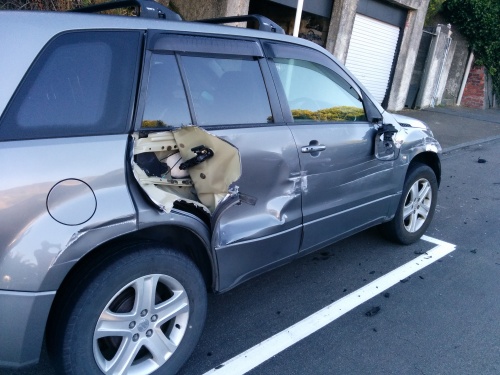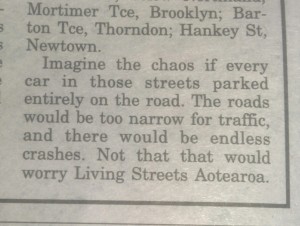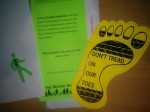Not long ago, I took a stab at the issue of Wellington City Council forgiving/ignoring/encouraging cars parked on suburban footpaths. Coincidental to that, The Wellingtonian ran an article and an editorial on the subject.
Before I go any further, I should mention that I’m a member of Living Streets Aotearoa. I think they do good work and I support walking, both with my wallet and with my feet. Especially with my feet, averaging around 10 hours/week. My commute is largely centred around the bus and as we now all know, buses are pedestrian fountains. I am also a father to a little monster and we do heaps of walking together, except I do most of the walking, with him in a buggy or in a carrier.
It was hard to miss the parked cars on footpaths even before parenthood. I’d see them while walking the dog in the morning or while running to and from the gym. Sometimes I’d take photos and send them in to WCC, but the only time anything was ever done was a repeat offender on Tasman Street who we’d reported every morning over a week.
Wellington’s narrow streets have long caused difficulties for drivers, whether it be navigating around parked vehicles or finding a place to park safely.
Although it is illegal to park on a footpath, Wellington City Council said it was willing to “cut motorists some slack” on narrow streets and as long as people were considerate they wouldn’t be ticketed.
But Living Street Aotearoa president Andy Smith said the law was the law and the group was not apologising for the fliers, which he said they had used around the country since 2004.
“The footpath is not a carpark. It’s as simple as that,” he said.
The law is incredibly clear on the subject.
Parking on footpaths or cycle paths
(1)A driver or person in charge of a vehicle must not stop, stand, or park the vehicle on a footpath or on a cycle path.
(2)Subclause (1) does not apply to cycles if a road controlling authority indicates otherwise by means of signs or markings or if it installs facilities for the parking, standing, or storage of cycles on a footpath or cycle path.
(3)Nothing in subclause (1) prevents a person from stopping, standing, or parking a cycle, mobility device, or wheeled recreational device on a footpath if doing so does not unreasonably obstruct any other user of the footpath.
This is the same law that applies over the whole country and Wellington isn’t special for having hills and narrow streets.
I’m not without some sympathy, however. We’ve had to replace a wing mirror on our car because of an errant driver, which is frustrating and annoying. However, we won’t be parking on the footpath to try to prevent it. Besides, I’m not sure if an extra few centimetres would have prevented the other big hit that our car took. There are some really bad drivers out there.
Council spokesman Richard MacLean said that though the law was the law, the council and Living Streets Aotearoa differed on how strict it should be enforced in this case.
“There are so many streets in Wellington where if people parked entirely with their wheels on the road it would actually block the street. We try to take a pragmatic approach,” he said.
With the recently agreed-upon draft cycling framework, Wellington City Council is proposing a policy of using the streets for mobility.
So the question must be asked – if there isn’t adequate space for parking on the road, why is there parking allowed? If the road is too narrow for private cars and service vehicles to pass parked cars, then surely the provision of parking is misguided. Put even better:
[tweet https://twitter.com/alphabeta_soup/status/593675388452233216] But nothing is going to stop people from whinging about car parking as if it were a right. Here’s the closing statement from the editorial in The Wellingtonian. There’s a few assumptions thrown in there that I fail to see as valid.
But nothing is going to stop people from whinging about car parking as if it were a right. Here’s the closing statement from the editorial in The Wellingtonian. There’s a few assumptions thrown in there that I fail to see as valid.
If every car on those streets were parked in an adequate parking space, there wouldn’t be an issue. There wouldn’t be crashes and the only people complaining would be people having to walk an extra minute or two to get to their car. Or, heaven forbid, use some of their land to build an off-street car park instead of depending on public land.
New Zealand has a cultural attitude that car is king. This is why Living Streets Aotearoa has to lobby for basic infrastructure and push back against the cars parking on the footpaths. It’s hard to enforce a vague rule, such as how much space is required for a pedestrian, buggy or wheelchair. As such, the vagueness will tend to lead to pushing of boundaries and collapsing into the remaining pedestrian space. This is a real problem when you start offering compromises by default.
Surely, the council stance on forgiving infringing behaviour and the media take on this is just representing what the average motorist wants to hear and they are the clear majority. Or maybe this is more the case:
[tweet https://twitter.com/badtom/status/593635077025701888]


Reblogged this on strathmorepark.
By: Strathmore Park on May 3, 2015
at 1:28 pm
[…] for pedestrians? Footpaths are the obvious one, getting a bit more attention at the moment as extra car parking space, but there’s more to it than […]
By: Verandahs, overhead pedestrian infrastructure | Sustainable Wellington Transport on May 6, 2015
at 12:37 pm
[…] in creating an ineffective law. We already struggle with all sorts of traffic problems, such as parking on footpaths or running red lights, where personal convenience is driving the bad behaviour and enforcement is […]
By: Should cyclists be forced onto cycle lanes? | Sustainable Wellington Transport on May 22, 2015
at 10:43 am
[…] Maybe it’s my imagination, but I’m noticing a lot more vehicles parking on footpaths than before. It could be confirmation bias or it could be the WCC parking policy getting announced all over the media. […]
By: Logging parking complaints | Sustainable Wellington Transport on June 2, 2015
at 2:52 pm